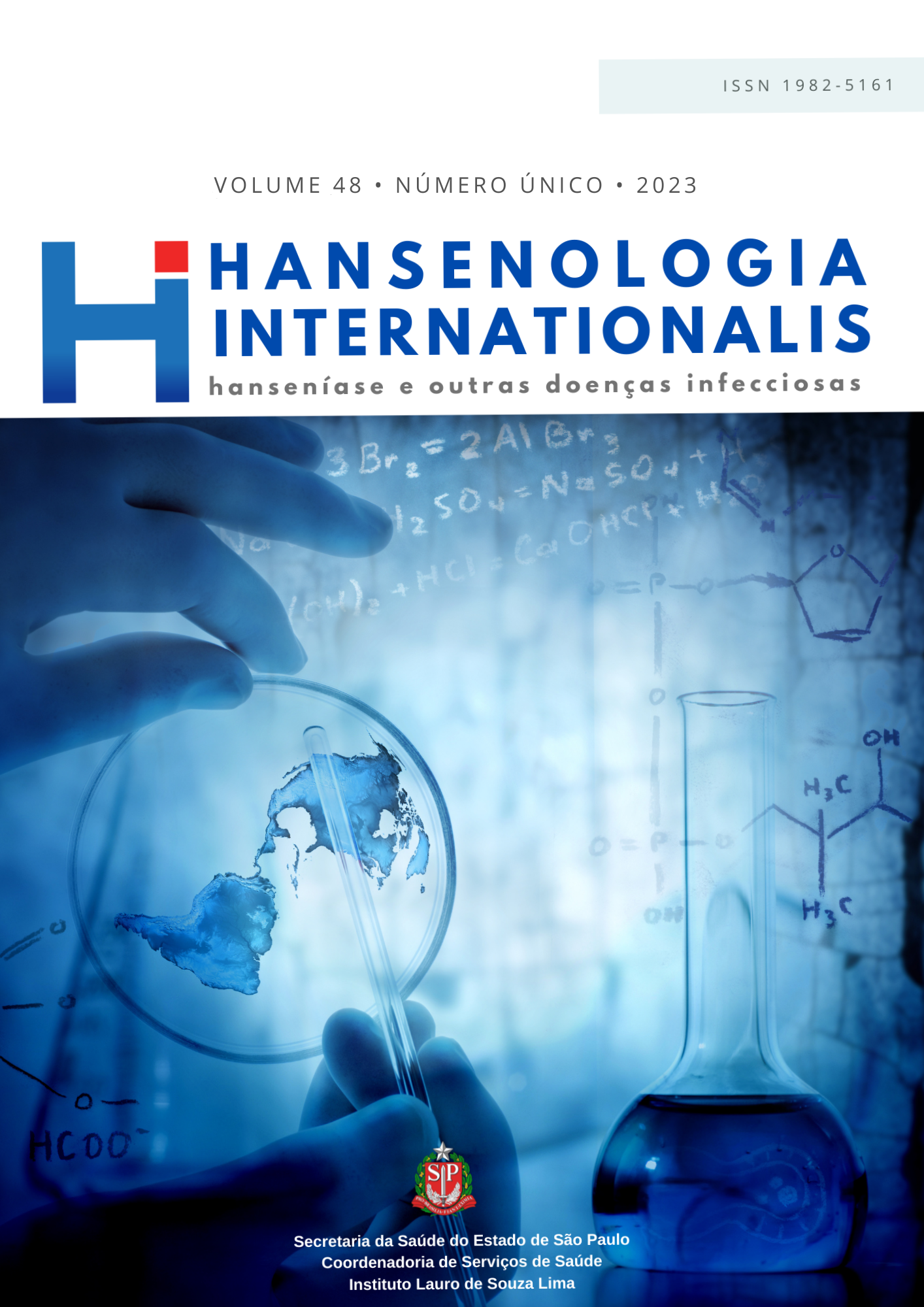Resumen
La lepra es una enfermedad infecciosa crónica causada por Mycobacterium leprae (M. leprae). Tiene una alta infectividad y una baja patogenicidad. El objetivo deste estudio fue relatar la identificación de un paciente con lepra multibacilar utilizando la prueba serológica (LID) durante una acción de búsqueda activa. Un paciente masculino de 54 años, residente en Governador Valadares-MG, proveniente de la búsqueda activa del Núcleo de Pesquisa em Hansenologia (NuPqHans/ UFJF-GV), presentó pruebla serológica positiva para la proteína recombinante del bacilo (ML0405/ML2331). Fui remitido al Centro de Referencia de Enfermedades Endémicas y Programas Especiales (CREDENPES), quejándose de lesiones cutáneas y nódulos por todo el cuerpo, refirió antecedentes de traumatismo craneoencefálico, mareos ocasionales, entumecimiento de los pies y hemorragia nasal. El paciente presentó resultados positivos de baciloscopia y biopsia, concluyéndose el diagnóstico de lepra multibacilar, recibiendo la terapia multimedicamentosa indicada. Después de tres meses de tratamiento hubo una reducción del área y diámetro de las lesiones en el abdomen, indicando la eficacia del tratamiento. El resultado positivo de la prueba serológica, permitió identificar a un paciente multibacilar que hasta entonces no había sido diagnosticado de lepra. Además, el uso de la prueba serológica LID en actividades de búsqueda activa en zonas endémicas para el diagnóstico precoz puede contribuir al concepto de lepra cero estipulado por la Organización Mundial de la Salud.
Citas
1. Ministério da Saúde (BR), Secretaria de Vigilância em Saúde, Departamento de Vigilância das Doenças Transmissíveis. Diretrizes para vigilância, atenção e eliminação da Hanseníase como problema de saúde pública: manual técnico-operacional. Brasília, DF: Ministério da Saúde; 2016.
2. Ministério da Saúde (BR), Secretaria de Vigilância em Saúde. Boletim Epidemiológico de Hanseníase[Internet]. Brasília: Ministério da Saúde; jan. 2022. [acesso em 24 jan. 2023]. Disponível em: https://www.gov.br/saude/pt-br/centrais-de-conteudo/publicacoes/boletins/epidemiologicos/especiais/2022/boletim-epidemiologicode-hanseniase-_-25-01-2022.pdf.
3. Bahmanyar ER, Smith WC, Brennan P, Cummings R, Duthie M, Richardus JH, et al. Leprosy diagnostic test development as a prerequisite towards elimination: requirements from the user’s perspective. PLoS Negl Trop Dis. 2016;10:e0004331. doi: https://doi.org/10.1371/journal.pntd.0004331.
4. Amorim FM, Nobre ML, Ferreira LC, Nascimento LS, Miranda AM, Monteiro GR, et al. Identifying Leprosy and Those at Risk of Developing Leprosy by Detection of Antibodies against LID-1 and LID-NDO. PLoS Negl Trop Dis. 2016;10(9):e0004934. doi: https://doi.org/10.1371/journal.pntd.0004934.
5. DuVall AS, Fairley JK, Sutherland L, Bustinduy AL, Mungai PL, Muchiri EM, et al. Development of a specimen-sparing multichannel bead assay to detect antiparasite IgG4 for the diagnosis of Schistosoma and Wuchereria infections on the coast of Kenya. Am J Trop Med Hyg. 2014;90(4):638-45. doi: https://doi.org/10.4269/ajtmh.13-0292.
6. O’Hearn AE, Voorhees MA, Fetterer DP, Wauquier N, Coomber MR, Bangura J, et al. Serosurveillance of viral pathogens circulating in West Africa. Virol J. 2016;13(1):163. doi: https://doi.org/10.1186/s12985-016-0621-4.
7. Marçal PHF, Fraga LAO, Matos AMM, Menegati L, Coelho ACO, Olmo R, et al. Utility of immunoglobulin isotypes against LID-1 and NDO-LID for, particularly IgG1, confirming the diagnosis of multibacillary leprosy. Mem Inst Oswaldo Cruz. 2018;113(5):e170467. doi: https://doi.org/10.1590/0074-02760170467.
8. Won KY, Kanyi HM, Mwende FM, Wiegand RE, Goodhew EB, Priest JW, et al. Multiplex Serologic Assessment of Schistosomiasis in Western Kenya: Antibody Responses in Preschool Aged Children as a Measure of Reduced Transmission. Am J Trop Med Hyg. 2017;96(6):1460-10.4269/ajtmh.16-0665.7. doi: https://doi.org/10.4269/ajtmh.16-0665.
9. BRASIL. Ministério da Saúde. Secretaria de Ciência, Tecnologia, Inovação e Insumos Estratégicos em Saúde. Portaria SCTIE/MS nº 67, de 7 de julho de 2022. Torna pública a decisão de aprovar, no âmbito do Sistema Único de Saúde – SUS, o Protocolo Clínico e Diretrizes Terapêuticas da Hanseníase. Brasília, DF, 07 jul. 2022. [acesso em 24 jan. 2023]. Disponível em: https://www.gov.br/conitec/pt-br/midias/protocolos/20220818_pcdt_hanseniase.pdf.

Esta obra está bajo una licencia internacional Creative Commons Atribución 4.0.
Derechos de autor 2023 Heloine Martins Leite, Marcos Daniel Silva Pinheiro, Daisy Cristina Monteiro dos Santos, Karolina Dias Campos, Lorena Bruna Pereira de Oliveira, Lucia Alves de Oliveira Fraga
